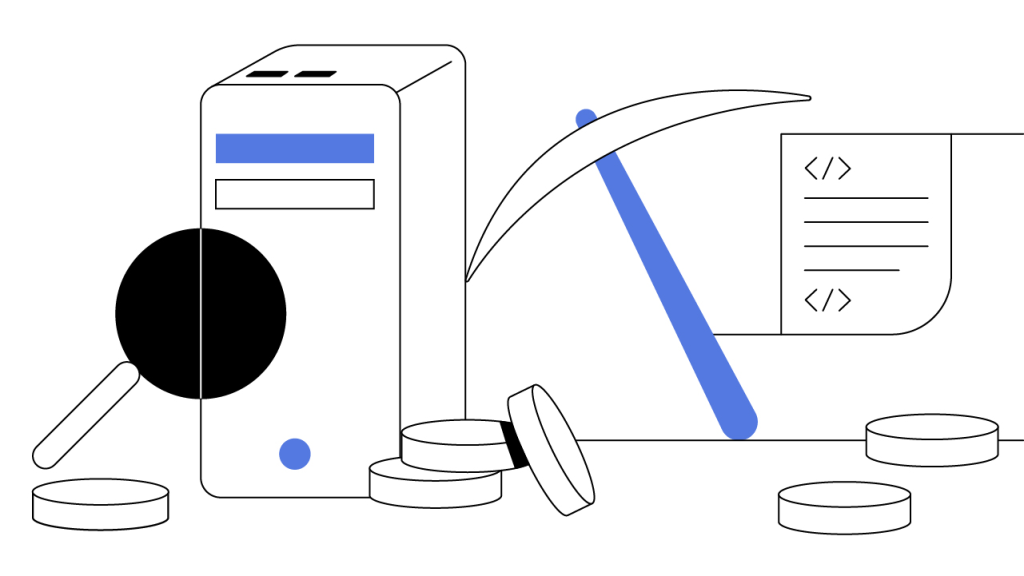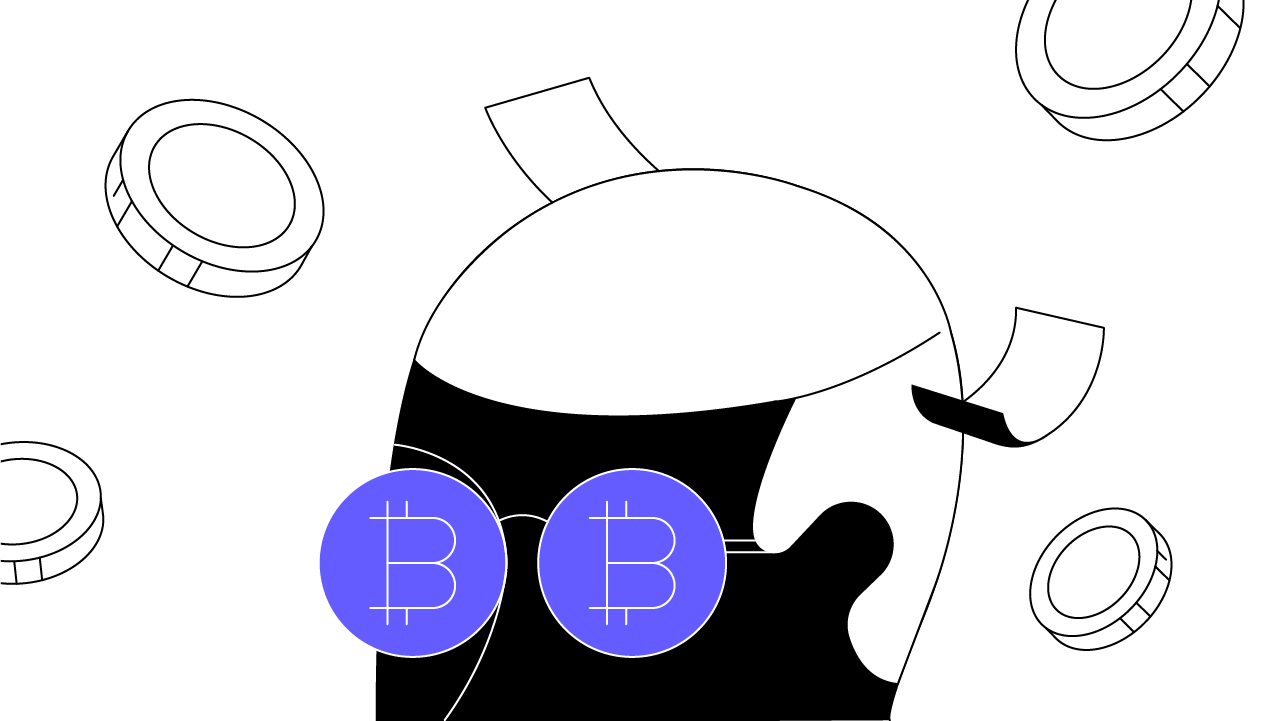Contents
How To Mine Bitcoin: A Guide to Mining Cryptocurrencies
Cryptocurrency mining is more than Bitcoin. Learn the basics of Bitcoin mining and other cryptocurrency mining opportunities you may not know about.
Updated February 6, 2025 • 10 min read

Summary
If you’re wondering how to mine cryptocurrency, you’re not the only one. The rise of interest in crypto investing, also has created an interest in crypto mining. With crypto mining, one size does not fit all. Crypto rigs come in various types and price ranges, and crypto mining operations can fit on a desk — or fill a warehouse. From Bitcoin to litecoin and doge, the processes for mining different cryptocurrencies have several similarities and differences. While there is some overlap in the processes for mining the various coins found on Proof-of-Work (PoW) blockchains, there are also some key differences, including mining algorithms, hardware costs, energy efficiency, and more. We’ll discuss the basics of mining cryptocurrency for beginners and dive into how to mine the various types of cryptocurrencies, such as BTC, LTC, DOGE, and BCH.
What is Cryptocurrency Mining?
For cryptocurrency to work, each crypto transaction requires being added to the blockchain. This is not only how new coins are minted but also how transactions get verified. New transactions can’t make it into the blockchain without mining.
Once transactions are verified and validated on the blockchain, they get added to what's called a distributed ledger.
To explain further, consider a more traditional ledger used with physical currencies, where transactions get debited and credited respectively. The same is true for cryptocurrency transactions, however, distributed ledgers with cryptocurrency must be verified by miners who update these transactions on the digital ledger.
A distributed ledger helps maintain the security and integrity of the network. Because distributed ledgers don’t have any centralized authority, mining is a critical component of the process for validating transactions.
As another layer of added security against attacks and to ensure that only verified crypto miners are validating transactions, a proof-of-work (PoW) consensus protocol is in place.
What Are the Pros of Mining Cryptocurrency?
Now that we’ve covered cryptocurrency mining, you may be wondering about the benefits and profitability of mining. Crypto mining has the potential to be profitable, but it’s important to understand the risks and costs involved alongside the potential benefits.
Potential for Profits
Crypto mining can be profitable under certain conditions, particularly if cryptocurrency prices increase and operational costs remain manageable. The way miners earn is through transaction fees as well as rewards.
Enabling Broader Accessibility
Miners play a part in helping cryptocurrency to achieve broader accessibility, as many people in the world live in areas that are unbanked, and therefore lack access to more traditional financial systems. Mining contributes to creating a global, inclusive financial network for some people who would not otherwise have access to financial systems or institutions.
Contribution to Decentralization
The very nature of mining is based on decentralization. By taking part in mining, this ensures decentralization is possible and maintained. The idea of decentralization means that no one person or entity has total power of the network, as power is distributed around the globe.
What Are the Cons of Mining Cryptocurrency?
All of this said, staying informed on the risks is also crucial so you can make an educated decision.
Risks
Anything that involves making money is typically associated with some level of risk. In this case, there is a bit of uncertainty with mining, as regulatory and legal aspects of mining are not set in stone. Some areas may have stricter guidelines and regulations than others. Because of this, there is some risk in investing in equipment, as well as the time and energy spent.
Price Volatility
It’s no secret that cryptocurrency is known for volatile price changes that can swing high and low, due to a number of factors that aren’t predictable. This can have an impact on the profits made by miners. Anyone who wants to get involved with mining cryptocurrency needs an entrepreneurial mindset.
Starting Costs
Anyone interested in mining will need equipment, and this needs to be factored into up front business costs, as well as maintaining equipment to ensure it’s reliable. Specialized equipment include items such as a GPU (graphics processing unit), FPGA (Field Programmable Gate Array) chips, an ASIC (Application Specific Integrated Circuit), and an SSD. Given the necessary equipment, these initial costs, as well as the cost for upkeep, warrant consideration.
Environmental Considerations
Some critics of crypto mining have argued about the negative impact on the environment, some studies suggest that Bitcoin mining can be a sustainable solution and contribute to energy efficiency in certain contexts.
Competition
Mining is mostly done at this point through crypto mining farms, rather than being done by individuals at home, but there are exceptions.
How To Mine Cryptocurrency
There are clearly benefits with crypto mining, and with anything, you must consider the benefits and weight them against the cost, effort, and risk. Many people are content to invest in cryptocurrency as passive investors, or as advanced, savvy crypto investors.
However, some people who are interested in cryptocurrency want to take it to the next level, and also have interest in cryptocurrency mining, particularly for popular coins like Bitcoin (BTC) and doge (DOGE). In general, mining crypto doesn’t need to be complicated, but given its nature, it can be as advanced as you would like.
Let’s start with some of the basics – the mining equipment necessary.
There is a vast assortment of crypto mining rigs from which you can choose. We touched on some of the equipment needed earlier. The main components are below.
These are all different types of mining hardware — and you can learn about them all in our deep dive on the subject.
These mining rigs vary in hash rate and energy efficiency, which are two of the key factors in determining mining profitability.
What Is Hash Rate?
Put simply, hash rate is a measurement based on the computing power of a given cryptocurrency network. It measures the “hashing power” used when transactions are processed on the blockchain.
For example, when calculating the hash rate for Bitcoin, the metric used is the number of times per second used by computers in the process of transaction verification.
Hash rate is an essential part of determining and projecting how profitable a miner will be. Every miner wants to be the first one to solve for their chance to validate blocks of data — if they’re able to achieve this, they get rewarded with minted currency.
Hash rate varies due to factors like the number of miners, as well as the level of difficulty involved in the process. By solving mathematical equations or puzzles via complex computer computations, miners can complete and verify transactions. This is how cryptocurrencies get added to the blockchain.
It’s worth noting that while crypto mining is often described as solving complex puzzles, this is moreso the way it’s depicted and less about what actually occurs. The process involves the generation of randomized numerical sequences, and this is where speed and efficiency come into play.
Additionally, the mining algorithms and overall mining process for various cryptocurrencies tend to vary. For example, you wouldn’t mine zcash (ZEC) with the same equipment — or in the same way — that you’d mine bitcoin cash (BCH).
Below, we’ll break down the similarities — and differences — in how you mine some of the most popular coins in terms of both market cap and mining interest.
How To Mine Bitcoin
Bitcoin is one of the most known and most popular cryptocurrencies, and many people have invested in BTC — but the truth is not everyone fully understands Bitcoin mining or how it’s done.
The Bitcoin blockchain is small by design, to make it more decentralized and more distributed. The configuration of the blockchain makes it very difficult to modify transactions — this is also by design.
Malicious miners would have to spend tens of thousands of dollars on equipment, electricity consumption, and use a lot of time to attempt to “outsmart the system.” Proper crypto Bitcoin mining takes time, money, and energy.
This is why some miners decide to join a miner's pool, which allows them to spread out risk and share rewards. In fact, it’s possible that approaching Bitcoin mining alone could require several years to mine even one Bitcoin.
While mining Bitcoin was once a feasible endeavor for home mining with accessible hardware, mining BTC is now largely dominated by large crypto-mining companies. Sometimes called crypto mining farms, these operations may use hundreds — or thousands — of ASIC miners optimized to mine BTC, which uses the SHA-256 algorithm.
These ASIC bitcoin miners are hot, noisy, and expensive — with prices varying from $2,000 – $15,000 USD each. For these reasons and more, mining BTC from home is more of a throwback to the early days of Bitcoin circa 2010, when the competition was lower and mining with home hardware was more feasible.
Nowadays, while nothing is stopping you from solo mining using a CPU, your chances of winning a block reward are statistically lower than winning the lottery. Even if you join a mining pool, the payout you’d receive from mining Bitcoin with CPUs and GPUs would be minuscule and would almost certainly be revenue-negative as any crypto payouts you’d receive in BTC would be overshadowed by the electricity costs your CPU or GPU miners would accumulate.
While BTC has become a highly competitive mining field, there are many more cryptocurrencies with which you can engage. Each of the crypto mining opportunities outlined below has its own special attributes and appeal.
How To Mine Litecoin
Mining litecoin (LTC), dubbed by its creator as “the silver to bitcoin’s gold,” is relatively similar to mining BTC. Litecoin has a block reward that finalizes four times as fast as Bitcoin’s, with new blocks being processed approximately once every 2.5 minutes. It also has a max supply of 84 million LTC, which is approximately four times as large as BTC’s. However, a key difference when it comes to mining LTC is the mining algorithm Litecoin uses.
In place of SHA-256, Litecoin uses the Scrypt algorithm. The primary technical difference between the two is that Scrypt is a memory-intensive mining algorithm that requires possible solutions to be stored in a unit’s random access memory (RAM).
This was chosen to allow it to be CPU-mineable, as mining bitcoin at home became increasingly unfeasible. However, as was the case with BTC, mining LTC soon became only profitable (for most) when using more advanced and costly GPU mining rig setups. Although Scrypt was designed to be ASIC-resistant, ASIC Scrypt miners were subsequently developed and have since placed CPU rigs at a competitive disadvantage.
Litecoin is often recognized for its faster and lower-cost transactions compared to Bitcoin and many other cryptocurrencies. It’s becoming a high-demand crypto opinion due to its traits making it highly profitable and its attributes make it appealing to businesses.
Unlock the future of money on Gemini
Start your crypto journey in minutes on the trusted crypto-native finance platform
How To Mine Dogecoin
Dogecoin was a quick-rising cryptocurrency star that began as a joke by its creators who originally intended Dogecoin as a meme project to help grow public interest in crypto. Today, Dogecoin has taken on a life of its own and is now a sizeable multi-billion dollar cryptocurrency. Dogecoin has a block time of approximately one minute, ten times faster than Bitcoin’s, with each block reward equal to 10,000 DOGE. Unlike most PoW chains, the block reward for DOGE never diminishes; this means that DOGE doesn’t have a hard cap.
Dogecoin uses the same Scrypt algorithm that Litecoin uses, and could initially be mined with CPU and GPU miners. With the advent of Scrypt-optimized ASIC miners, those not utilizing them are now at a competitive disadvantage. In fact, some institutional and industrial-scale mining operations have plans in the works — or have already begun — to diversify their mining operations to include both DOGE and LTC mining at a significant scale.
Overall, Dogecoin has less competition than Bitcoin when it comes to mining. Dogecoin’s large supply and active community make it an option for miners seeking a steady block reward structure.
How To Mine Monero
Similar to mining ZEC, mining Monero’s cryptocurrency XMR was also optimized in an effort to allow retail miners to fairly compete for mining rewards with large crypto mining farms. While there may be some large-scale mining of XMR, there is far more retail crypto mining of XMR than some of the other blockchains that are dominated by huge industrial-scale mining operations. This is because Monero’s mining algorithm RandomX is designed to be — and has remained — largely ASIC-resistant.
The RandomX algorithm changes periodically, and as the algo changes, any ASIC optimized for the previous algorithm simply won’t be profitable. For this reason, most large crypto mining farms focus on mining BTC and other large-cap projects where scale, specialization, and ASICs give them a competitive advantage.
Because of these dynamics, Monero’s XMR is one of the last large-cap coins that can be mined at home with a reasonable chance of being competitive and profitable. This is because XMR is still CPU-mineable; in fact, it’s optimized for CPU mining.
A far cheaper option than ASICs, many of the best CPU miners of XMR cost between $50 and $200. Monero has a block time of two minutes, and its block reward will gradually decrease until May 2022, when the supply reaches 18.132 million XMR. After that, there will be a static 0.6 XMR block reward to incentivize miners to continue to secure the network.
Now that we’ve covered how to mine Monero, let’s talk about Bitcoin Cash and how to mine this gem that is lesser known than Bitcoin, as these two can be easily misunderstood.
How To Mine Bitcoin Cash
Did you know that Bitcoin cash was actually started by Bitcoin miners? It’s true. Their reasoning grew out of concern about Bitcoin’s future, and whether or not it would be scalable. This new Bitcoin cash can be achieved by initiating a hard fork, otherwise known as a change to the programming that renders the legacy programming as incompatible.
Bitcoin is definitely a dominant cryptocurrency compared to Bitcoin cash, and although is a viable option, has a much lower trading volume than it’s big brother Bitcoin. However, one upside to Bitcoin Cash could be less transaction processing time somewhere that isn’t as bustling as the Bitcoin network.
One main point that is different about Bitcoin versus Bitcoin Cash is that Bitcoin blocks have a size limit of 4MB, where Bitcoin Cash blocks (BCH) allow up to 32MB.
Mining BCH is a nearly identical process to mining BTC. As Bitcoin Cash is a fork of Bitcoin, the design parameters of the two cryptocurrencies widely overlap — including using the same SHA-256 algorithm. In fact, ASIC miners have been known to switch between mining the two coins.
Using crypto mining profitability tools, they typically mine whichever coin gives them the highest return on investment (ROI) at any given point. Using a combination of the current market price and the mining difficulty of these two coins, they are able to calculate which coin to mine to maximize returns.
For a simple example, if BTC is $50,000 per coin and BCH is $5,000 per coin, a BCH mining difficulty that’s 1/10 of BTC’s would result in identical returns (over the long-term), since a miner is 10 times more likely to win the BCH block reward. A BCH mining difficulty that’s 1/20 of BTC’s would result in BCH being twice as profitable to mine.
If BCH’s mining difficulty is 1/5 of BTC’s, BCH would be half as profitable to mine (all assuming the example prices above are static). For this reason, ASIC miners optimized for BTC are usually pointed at whatever SHA-256 coin is the most profitable to mine at the moment.
Beyond this, the other Bitcoin fork, Bitcoin Satoshi Vision (BSV), also uses SHA-256, so these miners may switch between all three of these coins (BTC, BCH, and BSV) depending on the mining difficulty and current market price.
Bitcoin Cash hasn’t been around as long as Bitcoin so it doesn’t have the same level of liquidity as Bitcoin, but it is a viable choice for crypto mining.
The Bottom Line
Bitcoin mining can be profitable and rewarding at the same time, as it contributes to the decentralization and accessibility globally. Crypto mining is an exciting community to be a part of, and the cryptocurrency ecosystem is rapidly evolving. Considerations for crypto mining include weighing out the risks, and understanding the competitive nature of mining.
Although, it is most widely known, crypto mining isn’t limited to just Bitcoin, and other crypto options are available. Opting to mine for these other lesser-known cryptocurrencies may prove to be less competitive, as the more miners you have on a given blockchain, the more competitive it is to mine a cryptocurrency. Other cryptocurrency mining options include Litecoin, Dogecoin, Monero, and you can even mine Bitcoin cash.
Whether you’re about to start mining for the first time, are a seasoned crypto investor, or just want to learn more about cryptocurrency mining, you can find resources on our Cryptopedia.
Cryptopedia does not guarantee the reliability of the Site content and shall not be held liable for any errors, omissions, or inaccuracies. The opinions and views expressed in any Cryptopedia article are solely those of the author(s) and do not reflect the opinions of Gemini or its management. The information provided on the Site is for informational purposes only, and it does not constitute an endorsement of any of the products and services discussed or investment, financial, or trading advice. A qualified professional should be consulted prior to making financial decisions. Please visit our Cryptopedia Site Policy to learn more.

Is this article helpful?


